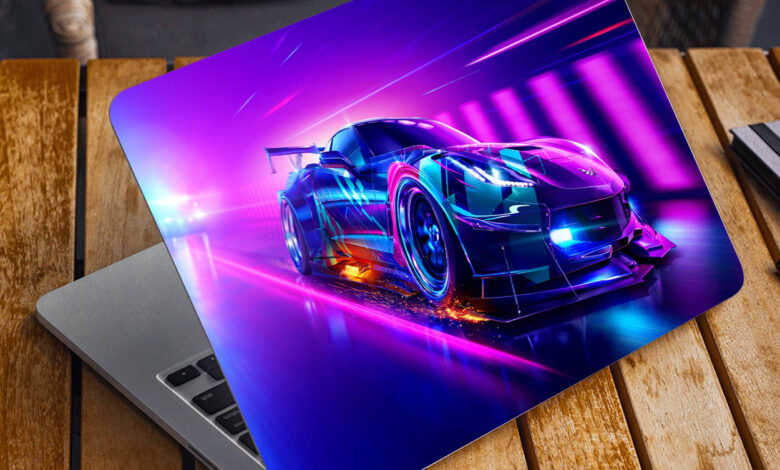From Cars to Laptops: The Best Surfaces for Applying Decals

Decals are a fantastic way to personalize and enhance a variety of surfaces, from cars to laptops. They add style, promote your brand, or simply bring a touch of creativity to your possessions. However, to ensure a flawless application and long-lasting results, it’s crucial to choose the right surface for your decal. Here’s a guide to the best surfaces for applying decals and tips to make sure they adhere properly.
Cars and Vehicles
Why It’s a Great Surface: Vehicles are one of the most popular surfaces for decals due to their high visibility. Car decals can advertise businesses, show off personal designs, or add a custom look to your vehicle.
Best Practices:
- Clean Thoroughly: Before applying a decal, wash and dry the car’s surface to remove dirt, dust, and grease. This helps the adhesive bond better.
- Avoid Applying in Direct Sunlight: Apply decals in a shaded area to prevent the adhesive from drying too quickly, which can lead to bubbles and uneven application.
- Use a Squeegee: To ensure a smooth application, use a squeegee to press the decal onto the surface and eliminate air bubbles.
Laptops and Electronics
Why It’s a Great Surface: Laptops and other electronics are perfect for decals because they allow for personal expression and can make your device stand out.
Best Practices:
- Clean the Surface: Use a microfiber cloth and a gentle cleaner to wipe down the laptop or electronic device. Avoid using harsh chemicals that could damage the surface.
- Avoid Heat and Moisture: Ensure the surface is completely dry before applying the decal. Excessive heat or moisture can prevent proper adhesion and cause the decal to peel off over time.
- Apply with Care: Align the decal carefully before applying it. Once in place, smooth it out with a credit card or similar tool to avoid bubbles.
Walls and Home Decor
Why It’s a Great Surface: Wall decals are a popular choice for home decoration, offering an easy way to update a room’s look without the need for paint or wallpaper.
Best Practices:
- Prepare the Wall: Clean the wall surface with a mild cleaner and let it dry completely. Ensure the wall is free from dust, grease, and moisture for better adhesion.
- Choose the Right Decal: For textured walls, select decals designed for uneven surfaces. Smooth walls work best with standard vinyl decals.
- Apply Using a Level: For larger decals or wall art, use a level to ensure proper alignment. This helps prevent crooked or misaligned designs.
Glass and Windows
Why It’s a Great Surface: Glass surfaces, like windows, offer a transparent backdrop that makes decals stand out. They can be used for privacy, branding, or decorative purposes.
Best Practices:
- Clean the Glass Thoroughly: Use a glass cleaner to remove any streaks or residue. Dry the surface completely before applying the decal.
- Apply Wet: For large decals, spraying a light mist of water on the glass before application can help position the decal and eliminate air bubbles. Be sure to remove excess water.
- Use a Squeegee for Smoothness: Smooth out the decal with a squeegee to ensure it adheres well and remove any remaining bubbles.
Personal Items (Water Bottles, Phone Cases, etc.)
Why It’s a Great Surface: Personal items like water bottles and phone cases benefit from decals that add personality and individuality.
Best Practices:
- Ensure Cleanliness: Clean the surface with a gentle cleaner and let it dry. Avoid applying decals to surfaces with textures or ridges that can interfere with adhesion.
- Apply Carefully: For small or curved items, take extra care to align the decal properly and press it down firmly to avoid wrinkles or bubbles.
- Seal with a Protective Coating: For items that are frequently handled or exposed to moisture, consider applying a clear protective coating over the decal to prolong its lifespan.
Furniture
Why It’s a Great Surface: Furniture decals can transform the look of pieces such as cabinets, drawers, and tables. They offer a cost-effective way to update or customize furniture.
Best Practices:
- Prepare the Surface: Clean and dry the furniture surface thoroughly. For best results, lightly sand glossy surfaces to improve adhesion.
- Apply on Flat Areas: Decals adhere best to flat surfaces. For curved or intricate furniture pieces, use decals designed for uneven surfaces or apply with extra care.
- Smooth Out Creases: Use a flat tool like a squeegee to smooth out the decal and remove any air bubbles or creases.
Promotional Materials
Why It’s a Great Surface: Promotional materials such as banners, signs, and packaging often use decals for branding and advertising.
Best Practices:
- Select Durable Decals: Choose high-quality, weather-resistant decals for outdoor use. Ensure they are designed to withstand various environmental conditions.
- Apply Evenly: For large promotional decals, ensure they are applied evenly and securely to avoid peeling or damage.
Final Thoughts
Choosing the right surface for your decals and following proper application techniques are essential for achieving the best results. Whether you’re customizing a car, decorating a room, or branding promotional materials, understanding the characteristics of each surface and adhering to best practices will ensure that your decals look great and last longer. By paying attention to surface cleanliness, application methods, and the type of decal, you can successfully enhance and personalize a wide range of items with ease.
Keep an eye for more news & updates on USA Fast Magazine!





